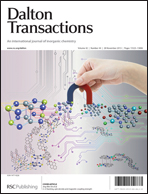Synthesis, structure, and reactivity of tris(amidate) mono(amido) and tetrakis(amidate) complexes of group 4 transition metals†
Abstract
The syntheses of a series of tris(amidate) mono(amido) titanium and zirconium complexes are reported. The binding motif of the amidate ligand has been determined to depend on the size of the metal centre for these sterically demanding N,O-chelating ligands; the larger zirconium metal centre supports three κ2-(N,O) bound amidate ligands while the titanium analogue has one ligand bound in a κ1-(O) fashion to alleviate steric strain. Reactivity studies indicate that, despite high steric crowding about the tris(amidate) mono(amido) zirconium metal centre, transamination of the reactive dimethylamido ligand can be achieved using aniline. This complex is also an active precatalyst for intramolecular alkene hydroamination, in which protonolysis of one amidate ligand in the presence of excess amine is observed as an initiation step prior to catalytic turnover. Eight-coordinate homoleptic κ2-amidate complexes of zirconium and hafnium have also been prepared.


 Please wait while we load your content...
Please wait while we load your content...